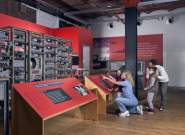A collaboration between Emily Oldfield and artist Simon Buckley (Not Quite Light, recently interviewed by Haunt Manchester's Dr Matt Foley here). All photographs by Simon, photographed on an iPhone.
The iconic Manchester musician and artist LoneLady is no stranger to the city’s outskirts. Compressed spaces, derelict buildings and borderlands have been recurrent themes within her practice, from her two previous albums Nerve Up and Hinterland to her ‘Shutters Down’ clubnights in the urban wilderness and ‘Scrub Transmissions’ sound installations. Now her latest ‘Scrub Transmissions’ work has emerged – evocatively titled DEMON (find out more here), hosted by The Social Gathering and embedded in a wall just off an industrial estate on Gorton Road, Manchester.
DEMON marks the third edition of ‘Scrub Transmissions’; an occasional installation project that involves LoneLady (previously interviewed by Haunt Manchester here) embedding an mp3 player into the fabric of a structure, at a location in the city or on its edges. The choice of Gorton Road is a bounty of borders… the areas of Gorton, Ardwick and Beswick bleeding into each other. A hotchpotch of hard surfaces still cannibalised by scrubland plants, foliage flexing its tongue through red-brick cracks. Haunt Manchester’s Emily Oldfield decided to travel by foot to pay a visit…
I ran to DEMON like a reckoning. From my room in Hulme, I rehearsed the route in my head, crossing Oxford Road, through Ardwick, out onto Ashton Old Road before the final turn. The skeletons of the city’s streets ever-more pertinent at the time of pandemic. I put on my running shoes and set off.
It was the type of late afternoon where the cloud hangs like wet wool, the atmosphere dredged in a damp warmth… a breath coming too close. I headed down Streford Road, cutting through a university campus emptied of students, the façade of the new Poetry Library shining slightly like a nervous smile. Possibilities glimmering, creative engagement entreats us, even during the times we are afraid.
I crossed an eerily quiet Oxford Road, courted by the occasional bus, windows revealing only eyes looking back warily from behind protective masks. Onwards, past The Deaf Institute and up Grosvenor Street, I hit the intersection with Upper Brook Street, its complication of cold railings and bike lanes – splitting Grosvenor in half in a tarmac tourniquet. I crossed again to continue my journey up Grosvenor, under the towerblock with its grey window-dented stare, the new housing development to my right in its polished pledge of ‘new’. Nothing stays ‘new’ for long around here.
Another crossing is Stockport Road as it reaches down towards Levenshulme in its long, pock-marked arm. Memories of journeys on overheated 192 buses very far away. My straight line wavered slightly as I took a turn on my left to head along the back of Ardwick Green, the small park surrounded by faded Victorian grandeur, former lads clubs. I fell into the faded footsteps off what was once a social throng, wondered at the name of ‘Cakebread Street’ as I carried on pushing forwards, up onto Fairfield Street… the type of urban artery that oozes into another with little warning. This becomes Ashton Old Road. This palimpsest of pace stretching outwards and underfoot mades me reflect on the route LoneLady may have taken to first find DEMON, whether Simon too fell into her footsteps when he first went to visit the installation. Would I pick up the leylines of their looking, would I traverse the trace of their touch?
Out on the road, I looked back onto the scattergun architecture of the city, the curve and hiss of the railway tracks likesome serpentine carcass, a metallic blood-tang heavy in the air. I looked for the shadows against the busy building sheen. The only pedestrian visible on this stretch, it was as if a kind of film-reel flexed through me, eyes archiving an imprint of the city, its pulse of urban mystery somehow more exposed in the pandemic lull. Then a lorry horn leached into the air in a ripping leer. DEMON coming close.
The edgelands are areas of so many possibilities of identity, arching beyond corporate ideology, the plush personas of planning. I thought I was following the map in my head, but instead I was drawn into the tug and adrenaline thump of curiosity, passing a largely shuttered row of shops; only an Off-License open, its multi-coloured bottles of alcohol like the captive novelty of Christmas tree lights. On the far side of the road, another housing development emerged like a shout, the attempted optimism of modern design in a desperate dance of jutting angles and catalogue colours.
An empty petrol station lay in wait… and just beyond, the unsure beginnings of Gorton Road.
DEMON is here. A ghost imprint on a red-brick wall, its faded white outline – a frame goading the eyes to manifest meaning, filling. I felt instantly tested, the mind-map in my head dissolving into a guessing game of DEMON’s origins… who came all the way here to write it? When? Am I undoing history or creating it? The geography of possibility ripples through, dredges its hardness. I walked from its N down to the D, metal fencing and foliage above my head, facing me on the other side of the road.
Warm skin on hard surface. What is it within ourselves that draws us to touch, a try to trace the story? Aching for the archaeology of embrace, in some way. I knew, for that moment, that I stood in the ebb of those before me, as I too will have left a trace. Touch is what so many of us are stretching for at the moment, yet cannot – social distancing measures warning of our potential threat to others, transmission. Now we are all closer to DEMON than we think. I pressed my palm into the centre of D and held it there. Was it DEMON that I feared? Holding my hand to the wall, almost like something beyond myself, I found that it was not the place I shied from, but the passing rattle of cars, the suspicious stares from within.
Yet entering the edgeland, I let my own suspicion become surrender. Continuing to trace my hand along the wall, along to a jutting black pipe plastered vertically with read lettering ‘SCRUB’, I let it fall. At the edges, we can abandon conceptions of ourselves and create anew. I found myself increasingly unfazed by passing cars as I carried on, attempting to avoid trampling rough rasps of foliage close to my feet. Grey-green leaves licked with rust. They seemed to sprout from tarmac pores, hang from holes in the wall, in a kind of interruption… a reminder that ‘urban’ is just an umbrella term. For this place pushes against definitions, DEMON declares no meaning, instead draws questions.
I wonder at what point the photographs will be taken? Where memory crystallises? Curiosity. It was then I wanted to turn to the passing drivers, our mere metres-apart bodies muted by metal, and say, come and join this with me.
For at DEMON, I was not alone, a graffiti heavy carcass of a building in the corner of my eye, a totem of temptation. Transgression is not always negative, something I have come to learn, we can break expectations, exit the structures society so commonly expects. As part of this ‘Scrub Transmission’ LoneLady embedded an mp3 player into the wall itself, the music playing on loop within the structure, its fizzing energy unfurling into sound when headphones are plugged in. I found the red arrow and inserted my own cable, suddenly bound into brick… and then further.
At first, a reading rolled into my ears. The searing syllables of a reading, LoneLady lingering over the words ‘Forged in red-brick are all my yearnings. You can’t go back – can you?’
I can’t go back, even this essay is an attempt to touch a memory, taken by DEMON, dredged through the edgelands – not now at the desk where I sit and type. It has taught me to treasure the moment, the experience in in itself. And as I listened, ‘Nestled in brick, you toy with my fate’, fell before the music. LoneLady’s own cover of Pink Industry’s Bound By Silence bristled through my headphones, the tethered listener of my body becoming lost in the groove. We are all dancing with one DEMON or another. The map in my mind melted under my feet. Out in the edeglands, we are unbound.
- Emily Oldfield, 16 May 2020
A Journey to the Edgelands – By Simon Buckley
Even though all our journeys begin at varying times, and spring from many varied sources, we still seem consistently able to cross the paths of strangers we then decide to treasure, who become forever part of our existence. Each step we take is the conclusion to every choice we've made so far, one leg back, one foot forward, leading us towards the collisions of coincidence that define our lives. Shared experience can claim us when we believe we're alone.
I decide to be 'a visitor' and leave from Piccadilly Station on this strange pilgrimage, the journey taken, and resulting experiences, now ordained by this simple decision. I make my way through streets that are familiar yet unsafe, old yet restless.
This is where the work is done, where Manchester people live their lives. The increasing traffic along Ashton Old Road blows dust and filth into my lungs, and I think of the lost walk on the open moor.
On Gorton Road, I find Scrub Transmissions, where the artist Lonelady has embedded an MP3 player into some cement. I plug my headphones into the wall to listen to the songs and poetry. This is what drew both Emily and I to this location. Is it possible for there to be ghosts without there being existence beforehand?
My partner is with me, not from this city or even this country. But she too seems to understand. So many paths and journeys, and yet we all find each other when we need to. The sky turns deep blue, slithers of pink and yellow take an age to wither.
By Emily Oldfield and Simon Buckley
Image credit: Simon Buckley, photographs taken on an iPhone







